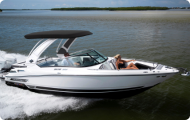Our BoatUS editors share their most difficult boat-cleaning dilemmas. Here are some slick solutions.
When it comes to tackling your most troublesome cleaning jobs on board, the internet is chock full of advice. Some tips are pure genius; others are downright dangerous. We set out to find some clever (and safe) solutions to five of your toughest challenges. While you shouldn’t discount commercial products, items you may already have on hand can serve up surprisingly good results, sometimes for less money. When it comes to getting out tough stains, your first responsibility is to do no harm. You don’t want to turn a molehill into a mountain, so we recommend, where possible, to contact the manufacturer of whatever item you want to clean to ask for advice. Read labels on all cleaning solutions carefully to ensure they’re safe for use on the surfaces you’re using them – and remember that formulas can change. Finally, test any product on a small, inconspicuous area first to ensure there are no unexpected results.
Problem: Stains On Vinyl Cushions
Whether it’s stains from mildew or (ewww!) spider droppings, dirty vinyl looks bad and decreases your boat’s value.
Solution: OxiClean powder, or its generic equivalent, offers up great results for removing stains on vinyl. Mix according to the directions, and gently scrub with a nylon bristle brush. Let sit for five to 10 minutes, then rinse. You can also try cleaning tough spots with a Mr. Clean Magic Eraser. Avoid using products containing bleach; they will break down the vinyl and stitching over time.
Prevention: Once the stains are gone and the material dry, finish with a sealer like 303 Aerospace Protectant.
Problem: Foggy Portlights
You clean your boat’s plastic portlights over and over, but they’re still hazy. The plastic is probably oxidized or scratched, so no amount of cleaner is going to cut it.
Solution: Clean the window using warm water with a squirt of mild dishwashing soap added. Then squeeze some toothpaste or Brasso onto a clean, soft lint-free cloth (an old cotton T-shirt works great) and rub it onto the surface of the portlight until the oxidation is removed. Wipe with a clean cloth. If necessary, use a plastic-safe cleaner to remove any residue.
Prevention: Avoid using glass cleaner (or anything that contains ammonia, alcohol, or solvents) or dry paper towels for cleaning plastic portlights. After removing the haze, follow up with a water-resistant spray, like Rain-X, to slow down future oxidation.
Eco-friendly Cleaning Tips
Regardless of your choice of cleaner, how you use it can determine your environmental impact as much as the toxicity and degradability of the product itself. Factors such as how much you dilute a product, how much you use, and where you clean your boat all contribute to the amount of product that ends up in the environment. Here are some tips to remember:
- Rinse your boat regularly with freshwater to prevent dirt from accumulating.
- Follow the dilution recommendations on all cleaning products. In most cases where a product had a range of recommended dilutions, the weaker mixture works equally well as the stronger mixture.
- Use an environmentally friendly boat soap for overall cleaning, then spot treat troublesome stains with a stronger product.
- Minimize runoff by toweling off harsh spot treatments instead of rinsing.
Problem: Dirty Bilge
A wet, dirty bilge isn’t just an eyesore: It can bring unwanted odors, and pumping out oily water is illegal. In addition, the muck makes it hard to spot small problems before they become big ones.
Solution: Turn off the bilge pump and use a wet/dry vac or sponge to remove any remaining water. Pour in some kind of degreaser, like a gentle dishwashing soap. Add a couple buckets of hot water, depending on the size of your bilge. Use a brush to scrub the surfaces, being sure to get into the nooks and crannies. Suck out the dirty water with your wet/dry vac and dispose of properly. (Avoid dumping the dirty water overboard. Doing so can carry a hefty fine.) Remember to switch on your bilge pump to the automatic setting afterward.
Prevention: Once your bilge is fully dry, add oil-absorbing pads in areas where grease or fuel could collect. Address ongoing leaks or drips, and clean up spills right away.
Problem: Fishblood Stains On Nonskid
While evidence of catches on your deck means you had a great day on the water, it’s just plain yucky to look at.
Solution: The best method is to wash down any affected surfaces before the blood has a chance to dry. Should you miss a spot, sprinkle some Bar Keepers Friend on clean, wet nonskid, scrub, and rinse. Alternatively, try hydrogen peroxide or OxiClean (or generic equivalent) for really tough dried-on stains.
Prevention: Thwart future stains with a coat of Woody Wax, which is safe to use on decks.
Problem: Hard Water Stains
Those icky white spots that appear on your hull, glass, or engine cowlings from mineral deposits mar your freshly cleaned finish.
Solution: Spray a mixture of equal parts vinegar and water, let sit for 5 minutes, then wipe off. Or keep a box of dryer sheets onboard. Moisten one with water, gently rub over the spots, then rinse for a sparkling shine.
Prevention: Immediately after washing in a shady area, spritz the surface with a 4:1 water/vinegar mix. Use a wrung-out chamois to remove water droplets before they dry. Then apply a coat or two of wax, like Woody Wax, to help keep water spots at bay. For very hard water, consider adding a dockside or inline water filter to remove the minerals.























